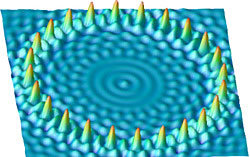Optical Corral

A circular arrangement of nanoscale pillars forms an optical corral which can "confine" light waves of certain frequencies.
Image courtesy of Phys. Rev. Lett. 86, 4950 (2001)
Above: Microbeads immersed in liquid floated freely at first (left) but gradually formed small crystals (right, 10 days later) in an experiment aboard the Space Shuttle. Larger crystallites devour smaller ones, even early on, when they are far apart, according to work that aims to elucidate the details of crystallization.
Image courtesy of NASA and Princeton University.
If you want to keep a horse confined, put it in a corral. Now, it appears the same thing can be done with light. A team of theorists shows how an arrangement of nanoscale pillars forms an "optical quantum corral" that can force light waves into a predictable set of quantum states. If the theory is confirmed by experiments, it will help researchers interpret images from scanning probe microscopes and may also lead to brighter fluorescent probes of biomolecules.
Read more about this research at Physical Review Focus.
Text courtesy of Physical Review Focus.











